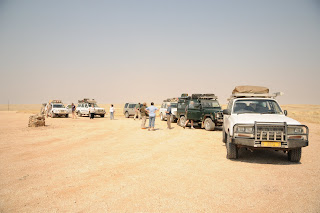Before launching into the actual blog of events, it’s informative to consider the actual amount of planning that goes into a trip like this. As I said, there will be times where petrol (gasoline or diesel) is not available and you can’t exactly call triple A if a breakdown should occur.
The team started planning well in advance of the trip. Three group meetings were held were the route was planned, meals and equipment discussed. Because there were 6 vehicles, it was decided to work together so certain equipment wouldn’t be duplicated and group meals were planned so not everyone would have to cook every night. I attended only the last meeting, where we discussed the final route and meal responsibilities as well as doing a final review of “important things to take”. It was agreed each car would cook dinner 3 nights, all would be responsible for their own lunch and we would have 5 group breakfasts at locations where we spent 2 nights. Food is always important. Other things to consider (and this is NOT all inclusive…just enough to give and idea but not bore to death):
 |
| Rykie and Roelof at the last planning session |
Items for the car (it helps that there were 3 Toyota Land cruisers, age 1995, 1996, and 1997):
· at least 2 spare tires
· spare fan belt, air filters, oil filters, fuses, water pump, and complete tool kit
· extra diesel (we brought 4 – 20 liter Jerry cans) and extra oil
· extra battery for help running the freezer when the car isn’t running
· straps and cable ties…and wet ones J
Camping equipment:
· tent…preferably tall enough to stand up in
· stretchers…for sleeping off the ground
· sleeping bag and pillow
· large pots for cooking group meals (cast iron number 2,3,6 and 7)
· gas bottles and stove tops for heating water
· all utensils and racks for cooking over wood fires, roasters for holding the meat
· wood…because nearly all cooking will be on wood fire
· freezers which run on the vehicle battery
· cool boxes for items that can be refrigerated with ice
· I took an inverter which plugs into the cigarette lighter and allows me to recharge my computer and camera batteries
· extension cords for when power is available to run the freezers
· extension ladder for climbing on top of the Landcruisers
Food and clothing:
· food for Salome and I to cook 3 group meals (she did most of the cooking)
· all food for breakfast and lunch
· spices, extra containers
· condiments, condiments, condiments!!!
· Beverages, beverages, beverages!!!
· plates, cups, forks, etc.
· toiletries
· clothing and laundry detergent
· sugar, grain meal and paper/pens to give to the Himba
Safety and security:
· Two doctors, one nurse and a satellite phone,…OK, one doctor is a retired gynecologist and what’s he going to do with all the women over 50 and up except prescribe Estrogen and Prozac? The gynecologist, Roelof, however, turned out to have many more needed and valuable skills…more on that later… Bertie Botha said the older we get the more we like to travel with our doctors!!
 |
| Richard Fryer (not on trip) packing the last items on top of Salome's Land cruiser |
So you can see there was a lot of planning and preparations that needed to occur. We prepared for more than a week in advance although the last week the pressure built daily. Finally, the morning of Sept 9, I said good bye to the hair dryer and with great relief threw all my lists of things to do into the trash bin.


















































